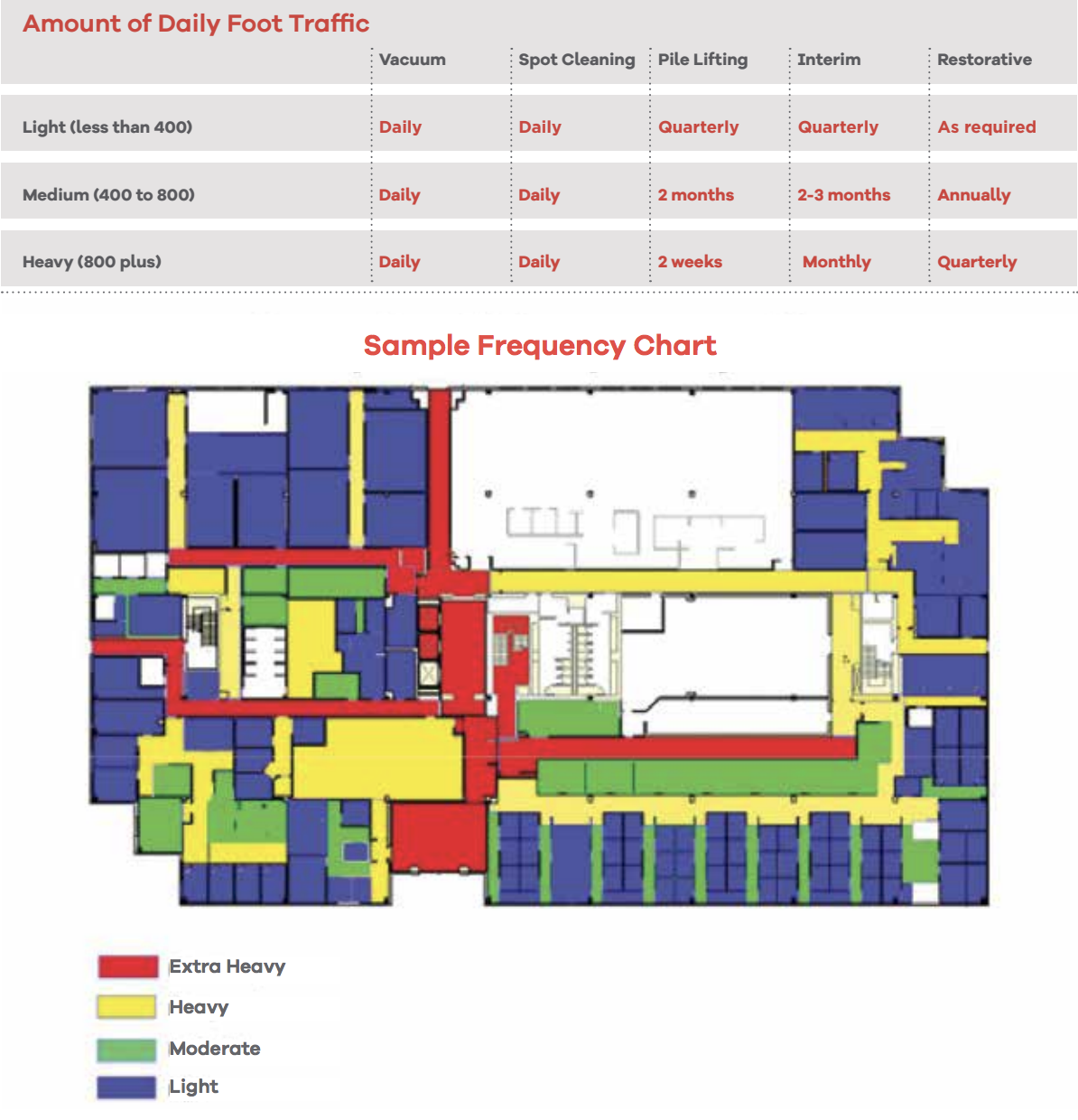Cleaning probably doesn’t top anyone’s list of favorite activities, but it’s a necessity, especially in a commercial environment. When approached properly and systematically, cleaning and maintenance of commercial carpeting — either modular and/or broadloom — protects your investment.
Mannington Commercial advocates the T.A.C.T. (Time, Agitation, Chemical, Temperature) approach to help keep carpet products performing at their best. Let’s take a closer look at what that means and how to approach preventative maintenance, daily routine cleaning, interim cleaning and restorative cleaning.
A site survey helps determine the volume of foot traffic in each area and the type of soil near each location which then determines cleaning methods and frequency. It’s common sense that areas near exterior doors will get dirtier but don’t forget interior traffic zones such as hallways and common areas.
In this article we will cover the following:
- Entryways
- The 80/20 rule for cleaning
- Establishing a Routine
- Vacuuming best practices
- Stain treatment
- Periodic Maintenance
- Intense Cleaning
In the Beginning - Entryways
A well-designed entryway flooring system helps trap excess dirt and moisture near the door, reducing the amount that’s spread to other areas. It also provides adequate traction for safety.
A proper entry of 10-15 feet is optimal to trap 80 percent of soil. Scraper mats remove large soil particles while products placed in manufacturing areas, kitchens, janitorial spaces, elevators and parking garage entrances both collect soil and water and reduce slipping.
The 80/20 Rule
Proper cleaning of entryways, lobbies and main traffic lanes helps reduce the amount of soil migrating through the rest of a building. A suggested guideline is to spend 80 percent of time and resources on 20 percent of carpet. Basically, it’s nipping the problem in the bud by vacuuming entryways and walk-off areas and spot cleaning daily.

Establish a Commercial Carpet Cleaning Routine
Let’s talk about how and where to clean daily to keep carpet in top condition and to extend the life of your commercial carpets.
Vacuuming
Using a dual-motor, upright canister or backpack with power heads to vacuum daily can reduce 80 percent of dry soil. Use a vacuum with a quality HEPA filter and concentrate on high traffic areas. To ensure maximum effectiveness, bags should be changed when they become half full.
Vacuum models that work well on leading commercial carpet products include, Clarke Carpet Master 200, ProTeam ProForce, Windsor Versamatic and NaceCare HD14. As always, equipment is only as good as those operating it, and it has to be used and maintained properly to be effective.
Stain Treatment for Commercial Carpets
Sometimes, however, vacuuming isn’t enough. Stains happen. When they do, it’s important to treat them as they occur.
While this isn’t rocket science, there is definitely science involved in doing the job properly.
Most spills on carpet can penetrate the surface and spread to the backing. Make sure to clean an area three to four times larger than the stain and flush the stain from the backing to ensure it doesn’t wick back onto the surface.
Use a cleaner that dries and can be vacuumed up, not one that becomes tacky or sticky. Use a neutral-pH cleaner (10 or under), and if it isn’t premixed, adhere to the recommended dilution rate – a higher concentration rate can be damaging. Here are some specific tips:
- Blot liquid spills with a white, cotton towel or use a mini extractor.
- Break up dry soil and vacuum. Then, use a white cotton towel to apply a pre-tested spot removal product. Blot and repeat until the stain is gone.
- Keep in mind that especially tough spots such as oil, grease, ink, wine, dyes, fruit juices, urine, drain or toilet bowl cleaners, acids, medicines, insecticides, mildew removers, etc., can damage carpet fibers and require specialty products for cleaning.
- Daily maintenance should include general spot cleaners, mild detergents with encapsulating properties and neutralizing or brown-out chemicals.
Periodic Maintenance
More intensive interim cleaning should follow a schedule ranging from quarterly for light traffic areas to every two-three months for medium use areas to monthly for heavily trafficked carpet. A low-moisture cleaning is a proactive method to extend the life of your carpet and requires minimum downtime.
Here’s what to do:
- Apply liquid crystallizing solution spray and scrub into the carpet with a twin cylindrical, counter-rotating brush machine. Working the chemical into the carpet opens the pile and loosens the soil on the fibers.
- When the carpet is dry, vacuum thoroughly to remove the residual solution and soil.
- Take your time and work slowly to achieve the best results.
- Repeat the process if necessary in high-traffic areas.
Using fewer chemicals is always better as is finding the best product for your carpet. Using a solution that doesn’t leave a tacky residue helps prevent resoiling, thereby helping your carpets stay cleaner longer.
Check your chemical by diluting the product with the recommended ratio, then placing a small amount in a dish. After it evaporates, check to see if there is a leftover sticky residue. If so, that’s the same stickiness that will attract soil to your carpet.
Intense Cleaning
If soil isn’t removed, carpet fibers become matted and abraded, reducing the viable life of the product. A routine maintenance schedule includes daily vacuuming, interim low-moisture cleanings, and quarterly or even annual wet extractions and restorative procedures. While the last processes are more involved, they are part of the overall maintenance of your carpet to ensure long wear.
Hot water extraction forcefully injects cleaning solution and hot water into the carpet, saturating the fibers. The solution is then extracted along with embedded soil through a powerful vacuum.
Rinsing the carpet with an extractor is critical. When residue is left on the fibers, it attracts soil which creates a cycle in which carpets never get fully clean.
Equipment instructions usually state to put chemicals in the tank, but a pro tip is to always pre-spray so chemicals have time to penetrate the fibers and emulsify the soil so it can be rinsed away.
Use a pile lifter to help loosen the embedded dirt. NaceCare DP420, Whittaqker or Windsor iCapsol models have proven to work well with leading commercial carpets.
Adhering to a regular maintenance schedule will help prevent damage to carpet fibers and keep it performing and looking its best. But If restorative cleaning is needed, perform pile lifting first, then wet extraction.
Work the chemical in with a dual counter-rotating cylindrical pile lifter then extract using plain water to remove the residue. Consider extractors such as NaceCare TP Series, Clark Clean Track L27, NaceCare Smart Kit or Tennant ReadySpace.
Words of Caution
Bonnet cleaning was designed for hard surfaces but is not recommended for carpet and can cause abrasion of the fibers. Mannington Commercial , for example, does not recognize claims or warranties where carpet is damaged from an ongoing maintenance program that uses the Bonnet method.
With any commercial carpets make sure to use the correct equipment as to not void any warranty you may have on the product. For Mannington carpets using any type of rotary machine with a bonnet, brush or pad; will damage your carpet and void your warranty.
Protect yourself and your commercial carpets
And finally, be smart. You’re dealing with chemicals. Like anything that comes with instructions, follow them! They are there for a reason, usually to keep you safe and in this case to give advice about how to expand the lifecycle of your commercial product.
Follow the instructions for use and maintenance, and read, read, read the Safety Data Sheets. Learning the smart practices and protecting your commercial carpets with quality products will allow you to protect yourself and your products for years to come.

